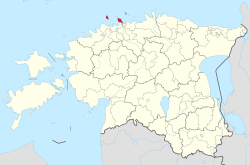Top Qs
Timeline
Chat
Perspective
Viimsi Parish
Municipality of Estonia From Wikipedia, the free encyclopedia
Remove ads
Viimsi Parish (Estonian: Viimsi vald) is a rural municipality in Northern Estonia, situated on the southern coast of the Gulf of Finland and neighbouring the capital Tallinn. With a population of 22,935 (as of 2025[update]),[4] Viimsi is considered to be the wealthiest municipality in Estonia.[5][6]
The municipality contains the Viimsi Peninsula and several islands, including Naissaar, Prangli, and Aksi. It covers an area of 72.84 km2 (28.12 sq mi).[2]
The flag and coat of arms of Viimsi Parish were designed by artist Tõnis Soop.[7][8] The mayor of Viimsi Parish is Illar Lemetti.
Remove ads
History
Summarize
Perspective
Archaeological evidence shows that Viimsi Peninsula has been inhabited since prehistoric times, with finds from the Neolithic and Bronze Age indicate permanent settlement dating back about 4,000 years.[9] The first written record of Viimsi appears in the Danish Census Book of 1241, where the village of Uianra (pronounced Vianra) was mentioned.

In 1471, the Pirita convent founded Viimsi Manor (mentioned as Wiems) which administered extensive lands on the peninsula. In 1866, a separate municipality was formed on the basis of Viimsi Manor, whose task was to organise the school, court and the fulfilment of certain state obligations. At that time, the municipalities were not territorial, but estate-based local governments, and the power of the municipality applied only to peasants.
After Estonia gained independence, the Viimsi Parish was officially established on 11 May 1919. In 1939, administrative reforms merged Viimsi with Iru Parish, and the area temporarily lost its municipal status.
During the Soviet occupation, Viimsi was part of a restricted coastal border zone. From the late 1940s, several fishing collectives were established in villages and in 1950, these were merged into the Kirov Fishing Kolkhoz, which became one of the largest enterprises in the region. The kolkhoz developed Miiduranna Harbour and engaged in fish processing, agriculture and greenhouse production.
Viimsi regained municipal status in December 1990 and following the Estonian Restoration of Independence, the area has transformed into a rapidly developing suburban municipality.
Remove ads
Divisions
There are two small boroughs (alevik) and 20 villages (küla) in Viimsi Parish.
Small boroughs
Villages
Äigrumäe, Idaotsa, Kelnase, Kelvingi, Laiaküla, Leppneeme, Lõunaküla (Storbyn), Lubja, Lääneotsa, Metsakasti, Miiduranna, Muuga, Pringi, Pärnamäe, Püünsi, Randvere, Rohuneeme, Tagaküla (Bakbyn), Tammneeme, Väikeheinamaa (Lillängin).
Population
The population of Viimsi Parish has seen a significant growth over the past decades, mainly driven by migration from Tallinn and new housing developments.[10]
Religion
Sports
Viimsi is home to several sports clubs, namely football club Viimsi JK, basketball club KK Viimsi and handball club Viimsi HC. The Viimsi Stadium was opened in 2015, replacing the former stadium. In 2018, Karulaugu Forus Sports Centre was opened adjacent to the stadium, together forming a complex for football, basketball, tennis, athletics and wrestling. In 2025, the Viimsi indoor football and athletics hall (Viimsi jalgpalli- ja kergejõustikuhall) was built for €6.4 million.
In 2022, KK Viimsi notably reached the 2021–22 Latvian–Estonian Basketball League final and finished as silver medalists.
Remove ads
Museums
International relations
Twin towns — Sister cities
Viimsi Parish is twinned with:[11]
 Barleben, Germany
Barleben, Germany Porvoo, Finland
Porvoo, Finland Ski Municipality, Norway
Ski Municipality, Norway Sulejówek, Poland
Sulejówek, Poland Täby Municipality, Sweden
Täby Municipality, Sweden Ramat Yishai, Israel
Ramat Yishai, Israel
Gallery
- Rohuneeme in 1938
- Buildings of the former Viimsi manor
- Viimsi Open Air Museum
- Põhjakonna stairs
- Viimsi Artium
- Rohuneeme
- Püünsi
- Private home in Viimsi
References
External links
Wikiwand - on
Seamless Wikipedia browsing. On steroids.
Remove ads













